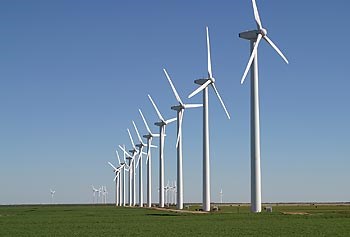State Awards $200K to Expand University’s Capabilities

UMass Lowell’s Wind Energy Research Group (WERG) aims to make wind-turbine systems more reliable and less expensive to operate.
04/05/2013
By Edwin L. Aguirre
Wind power is a clean and sustainable alternative to fossil fuels. It is plentiful, renewable, widely distributed and does not emit greenhouse gases during operation. Commercial wind power is typically generated on land or offshore by wind turbines mounted high on top of towers. As the wind spins the turbine’s long, massive blades, it turns a shaft coupled to a generator to produce electricity.
Thanks to comprehensive statewide policies to further develop and adopt clean energy, wind power output in Massachusetts has grown from just 3.5 megawatts (MW) in 2007 to 46 MW today. The Commonwealth’s ultimate goal is to reach 2,000 MW by 2020.
UMass Lowell’s Wind Energy Research Group (WERG) is one of the country’s leading organizations dedicated to helping make wind-turbine systems more reliable and less expensive to operate. Formed in late 2009, WERG consists of 13 interdisciplinary faculty members whose research focuses on turbine-blade manufacturing, design and modeling, reliability, structural health monitoring and non-destructive inspection, energy storage and workforce and economic development.
Recently, the group was awarded $200,000 by the Massachusetts Clean Energy Center (MassCEC) to help strengthen and grow its research capacity. The grant includes funding for a graduate-student program in conjunction with MassCEC’s Wind Technology Testing Center in Charlestown, as well as support for the continued development of WindSTAR, an Industry/University Cooperative Research Center funded by the National Science Foundation (NSF).
Sharing Knowledge and Expertise
WindSTAR’s research efforts will be led by UMass Lowell, in partnership with the University of Texas at Dallas, Texas A&M and Iowa State University. The center will train undergraduate and graduate students who will support and eventually spearhead the analysis, design, manufacture, installation, operation and maintenance of wind-energy systems. It will also provide a forum in which wind-turbine manufacturers, equipment suppliers, service companies and project developers can work together to solve problems that are of mutual interest. More than 50 wind-technology companies from across the country have expressed interest in joining WindSTAR.
“The center will further strengthen the wind-energy research cluster here in Massachusetts by bringing together universities and private developers to reach a common goal,” says Alicia Barton McDevitt, CEO of MassCEC. “Training the next generation of researchers will accelerate the development of high-performance wind-energy technologies designed to generate even more clean power from a single turbine.”
“UMass Lowell’s expertise in turbine-blade technology is helping the nation expand its supply of alternative, clean-energy sources. Our partnership with the Wind Technology Testing Center and the MassCEC will help ensure that Massachusetts is a center for advances in the industry,” says Chancellor Marty Meehan. “We are grateful to the MassCEC for their support of the important research being conducted by UMass Lowell faculty.”
Making Turbine Blades More Reliable
One of the biggest challenges facing wind-turbine makers and utility companies is the question of reliability of the turbine blades, either due to manufacturing defects or damage during operation.
“If the blades are not spinning, they are not generating electricity,” says mechanical engineering Prof. Christopher Niezrecki, who directs WERG. “This means loss of revenue for the companies and investors. Ultimately, such turbine downtimes raise the cost of generating electricity, making the wind farm prohibitively expensive to operate, especially when competing with fossil fuels.”
Researchers are using the University’s Structural Dynamics and Acoustic Systems Laboratory to look at new ways of detecting blade defects and/or damage. They are monitoring the vibration response of these blades during operation using optical sensing techniques, such as digital image correlation and photogrammetry with video cameras.
“This will help blade makers with quality control during manufacturing,” says Niezrecki. “It will also assist turbine operators in improving blade maintenance and avoiding costly repairs and replacements and help extend the life of the blade.”
He says turbine blades, which are made of fiberglass and other composite materials, can span up to nearly 300 feet in length.
“The challenge is that, as the blades get bigger and longer, the likelihood of having structural defects or failures increases,” he says. “The blades’ lifetime is supposed to be 20 years; right now, they don’t last that long.”
Last year, a multi-disciplinary team of researchers from UMass Lowell and Wichita State University was awarded nearly $1.9 million by the NSF to develop the next generation of wind-turbine blades. The team, led by Niezrecki, will create new sustainable, bio-derived materials for manufacturing the blades.
